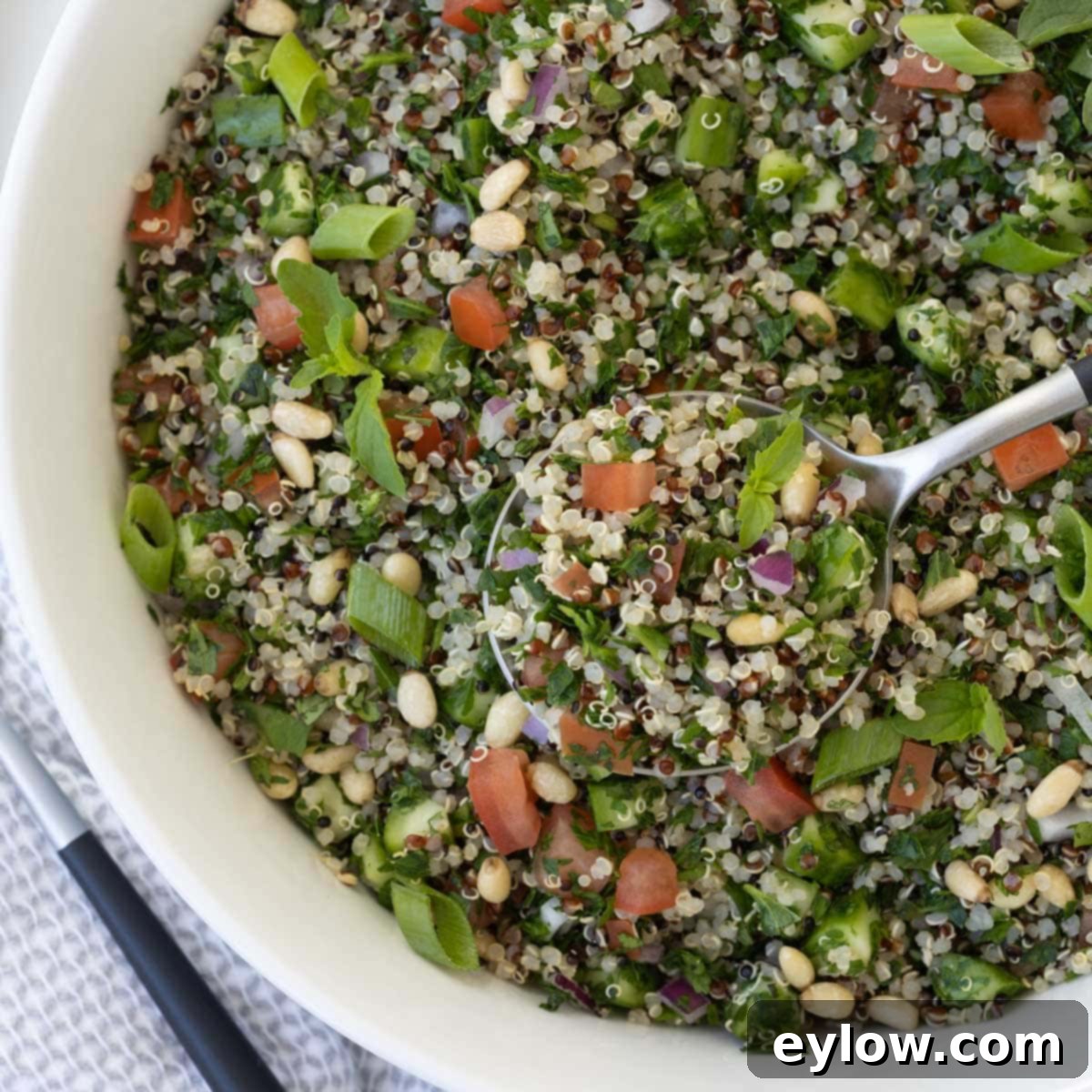Easy Gluten-Free Quinoa Tabouli: Your Ultimate Guide to a Refreshing Mediterranean Salad
Discover the vibrant flavors of the Mediterranean with this delightful and healthy **quinoa tabouli salad**. Often spelled as tabouleh, tabbouleh, or taboula, this classic dish is a staple of Middle Eastern cuisine, traditionally featuring finely chopped fresh parsley, invigorating mint, ripe tomatoes, and crisp green onions, all dressed in a zesty lemon and olive oil vinaigrette. Our special twist uses nutritious quinoa instead of bulgur wheat, making this version completely gluten-free without sacrificing any of its authentic taste or satisfying texture. Perfect for a light lunch, a side dish, or a vibrant addition to any meal, this easy-to-prepare salad can be made ahead of time and served chilled, making it an ideal choice for warm summer days or any time you crave a burst of fresh flavor.
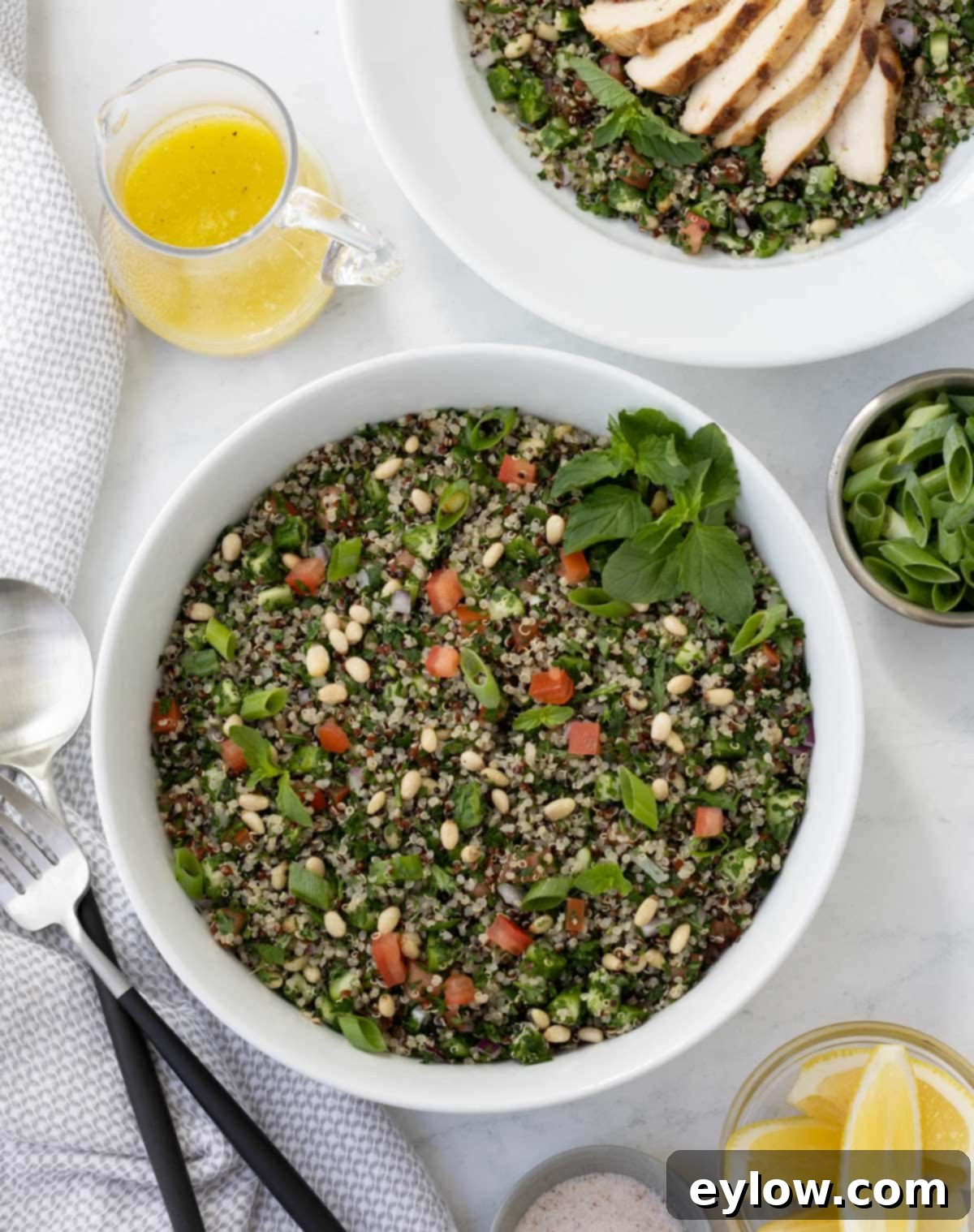
This Lebanese-inspired salad is more than just a side dish; it’s an experience of freshness. Forget about parsley as a mere garnish – in tabouli, it’s the undisputed star! We’re talking about generous quantities of finely chopped parsley, providing both incredible flavor and a beautiful green foundation for the entire dish. This recipe brings together a harmonious blend of textures and tastes, creating a truly sensational salad that you’ll want to make again and again.
Embrace the simplicity and health benefits of this versatile salad. Whether you’re looking for a quick weeknight meal, a show-stopping dish for entertaining, or a nutritious option for meal prep, our quinoa tabouli is sure to impress. Its bright flavors and refreshing qualities make it an instant favorite, proving that healthy eating can also be incredibly delicious and satisfying.
Why You’ll Absolutely Love This Quinoa Tabouli Recipe
This particular tabouli recipe stands out for several compelling reasons, making it a favorite in many kitchens. Its ease of preparation combined with its incredible versatility and health benefits ensures it will become a regular in your meal rotation:
- Incredibly Versatile Pairing: This refreshing salad is a fantastic accompaniment to a wide array of main courses. Its bright, clean flavors perfectly complement grilled chicken, succulent lamb, flaky fish, or delicate seafood like shrimp and scallops. It also shines as a standalone vegetarian meal.
- Bursting with Freshness: Crafted with a handful of simple, wholesome ingredients, this tabouli emphasizes maximum freshness. The vibrant herbs, crisp vegetables, and light dressing create a truly invigorating taste experience that’s hard to beat.
- Convenient Make-Ahead Option: One of the best features of this tabouli is its suitability for meal prepping. You can prepare all the components—cook the quinoa, chop the vegetables, and whisk the dressing—a day or two in advance. Store them separately and simply combine and dress just before serving for optimal texture and flavor.
- Naturally Gluten-Free & Healthy: By substituting traditional bulgur with quinoa, this recipe becomes a fantastic gluten-free option for those with dietary restrictions. Quinoa also adds a boost of complete protein and fiber, making this salad incredibly nourishing and satisfying.
- Perfect for Any Occasion: Whether you’re planning a summer picnic, a casual backyard barbecue, a holiday potluck, or just a simple weeknight dinner, this tabouli fits right in. It’s light enough for a warm day but flavorful enough to stand out at any gathering.
For another fantastic way to incorporate fresh parsley into your cooking, be sure to try this mushroom and parsley pasta sauce. It offers a hearty, savory flavor that’s wonderfully rich and satisfying, even without any meat.
Essential Ingredients for Your Quinoa Tabouli
While this recipe stays true to the spirit of classic tabouli, I’ve made a few adjustments to enhance its appeal and accommodate dietary preferences within my family. These tweaks include using quinoa for a gluten-free option, adding crisp cucumbers for extra texture, and incorporating both red and green onions for a beautiful color contrast and nuanced flavor. For those who enjoy a creamy, salty addition, a sprinkle of Greek feta cheese is lovely, but feel free to omit it to keep your tabouli completely vegan.

Key Components for the Quinoa Tabouli Salad
- Fresh Herbs: The cornerstone of any great tabouli! You’ll need an abundance of fresh parsley. Both curly parsley and flat-leaf (Italian) parsley work beautifully. I personally use flat-leaf as I grow it, and its slightly bolder flavor and softer texture are wonderful here. Don’t forget fresh mint leaves; their bright, cooling notes are essential for that authentic Mediterranean taste. Ensure your herbs are thoroughly washed and completely dry before chopping for the best results.
- Grain: To create a delicious gluten-free tabouli, we substitute traditional fine bulgur wheat with quinoa. Quinoa offers a similar light and fluffy texture, a mild, slightly nutty flavor, and the added benefit of being a complete protein. You can use either tri-color or white quinoa; both will yield excellent results. Remember to rinse your quinoa thoroughly before cooking to remove any saponins that might give it a bitter taste.
- Cucumbers: For the best crunch and texture, choose either crisp Persian cucumbers or a seedless English cucumber (also known as a hothouse cucumber). Whichever you choose, make sure they are fresh, firm, and have a vibrant deep green color. Dicing them small ensures they integrate perfectly into the salad.
- Tomatoes: Roma tomatoes are often preferred for tabouli due to their “meatier” flesh and lower water content, which helps prevent the salad from becoming soggy. However, the most important tip is to use whatever tomatoes are freshest and ripest at your local market. Choose firm, brightly colored tomatoes for the best flavor.
- Onion: Both red onion and green onion (scallions) can be used, and using a combination adds wonderful color and a balanced onion flavor. Red onion provides a slightly sharper bite and beautiful crimson flecks, while green onions offer a milder, fresher taste that is more traditional. Chop them finely to distribute their flavor throughout the salad.
Simple & Zesty Lemon Vinaigrette
- Olive Oil: The quality of your olive oil significantly impacts the flavor of the dressing. Opt for a good extra virgin olive oil for its rich, fruity notes. For an extra citrusy kick, lemon-infused olive oil also works wonderfully.
- Lemon Juice: Freshly squeezed lemon juice is paramount for this vinaigrette. Bottled lemon juice simply doesn’t compare in terms of brightness and flavor. If you’re out of lemons, lime juice can be a decent substitute, or use a combination of both for a unique twist.
- Garlic: One large fresh garlic clove, very finely chopped or zested with a microplane, will provide the best, most pungent flavor for your dressing. Avoid garlic powder for this recipe, as fresh garlic is key to its vibrancy.
- Salt & Pepper: A quarter teaspoon of sea salt and an eighth teaspoon of freshly ground black pepper will enhance all the flavors in the dressing and the salad. Adjust to your personal taste.
For precise measurements and quantities of all ingredients, please refer to the detailed recipe card provided below.
Chef’s tip on parsley: What kind of parsley is best for authentic tabbouleh? Traditionally, curly parsley is favored for tabouli due to its milder flavor and fluffier texture when finely chopped. However, flat-leaf parsley, with its slightly stronger flavor and softer leaves, is also an excellent choice and widely used. You can confidently use either variety based on availability and personal preference.
Creative Substitutions and Delicious Variations
One of the beauties of tabouli is its adaptability. While the core ingredients create a classic flavor profile, feel free to experiment with these ideas to tailor the salad to your taste or what you have on hand:
- For diverse grain options, if gluten isn’t a concern, you can use traditional fine wheat bulgur. Alternatively, couscous (wheat-based) or millet (another excellent gluten-free grain) can also be used, though they will subtly alter the texture.
- Add a delightful creamy and salty element with a little cubed or crumbled feta cheese or fresh goat cheese. This is a popular addition in many Mediterranean salads and complements the fresh herbs wonderfully.
- Seeking more texture, fiber, and protein? Incorporate canned, thoroughly rinsed, and drained garbanzo beans (chickpeas). They add a satisfying heartiness, making the salad even more substantial.
- For a buttery crunch and nutty flavor, consider toasting and adding **pine nuts**. They are a staple in Mediterranean cuisine and elevate the sensory experience of the tabouli.
- For an extra layer of creaminess and healthy fats, **diced avocado** is a fantastic addition (it was even my lunch today!). Add it just before serving to prevent browning.
- **Other vegetables:** Experiment with finely diced bell peppers (red, yellow, or orange for color), thinly sliced radishes for a peppery bite, or even finely chopped celery for added crunch.
- **Herbs:** While parsley and mint are essential, a small amount of fresh dill or oregano can be a lovely aromatic addition.
Chef’s Tip for Perfectly Chopped Herbs: The secret to beautifully chopped herbs that don’t clump or get mushy is dryness. Always wash your herbs thoroughly first, then dry them completely. A salad spinner is excellent for this. After spinning, spread them on a clean kitchen towel on the counter and allow them to air dry fully. Once dry, you can chop them by hand with a sharp chef’s knife for a rustic cut, or for a very fine chop, use a food processor. The trick with a food processor is to drop the dry herbs through the feed tube while the processor is already running – this prevents over-processing and ensures an even, fine chop.
Step-by-Step Quinoa Tabouli Instructions
One of the many benefits of this quinoa tabouli is its excellent make-ahead potential. You can cook the quinoa and chop all your vegetables a day in advance. Simply store them separately in airtight containers in the refrigerator. When it’s time to serve, combine them and add the dressing, ensuring a fresh and vibrant salad every time.


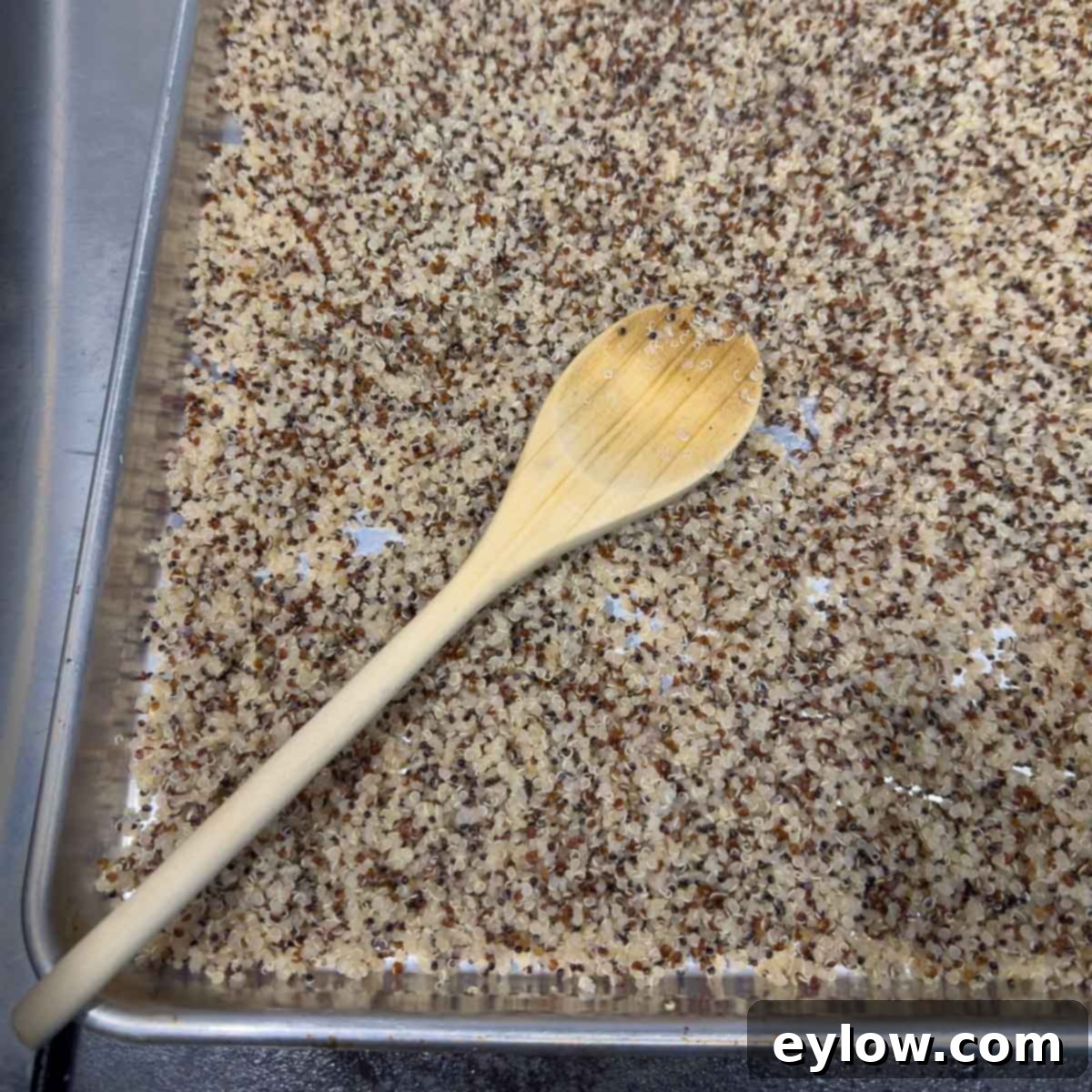
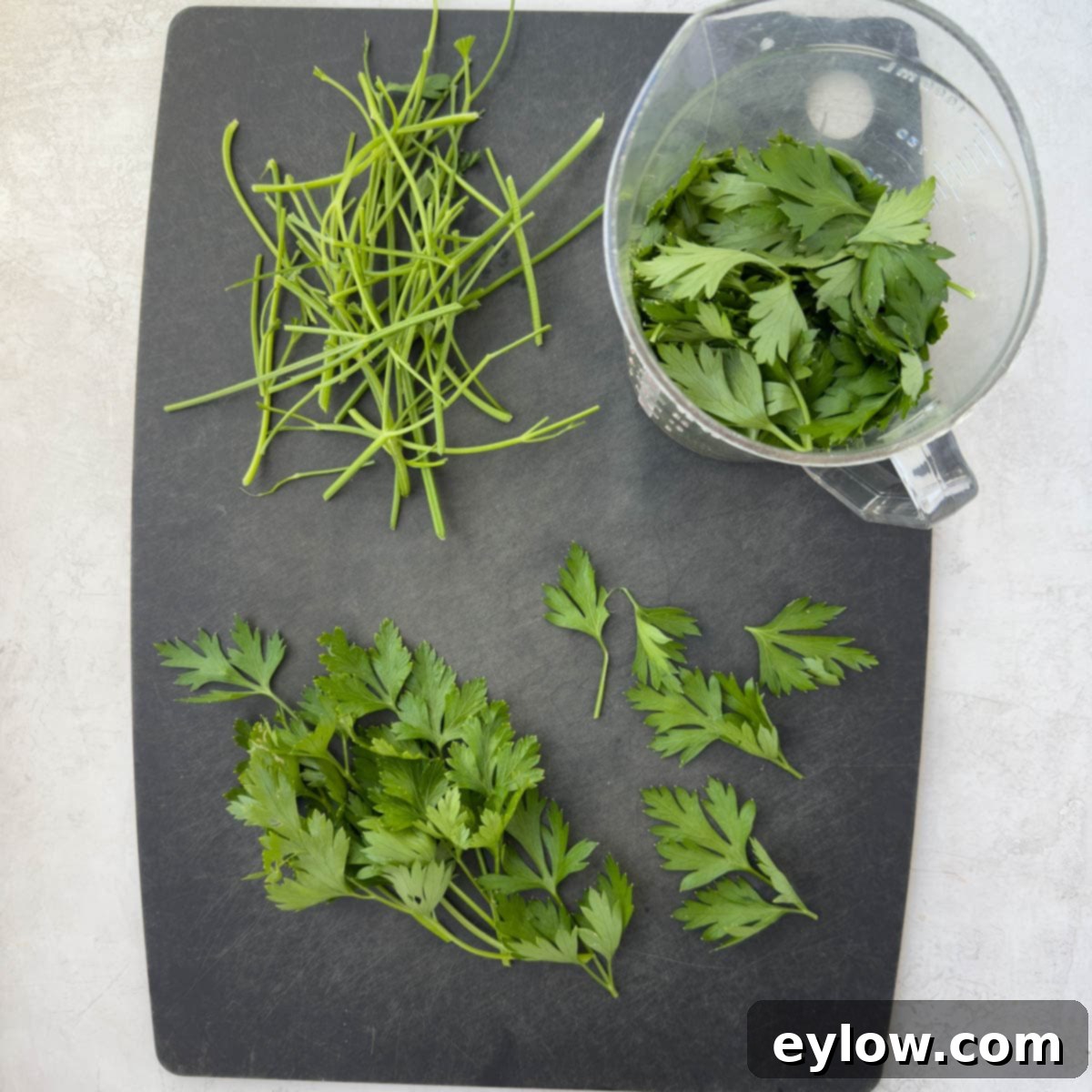

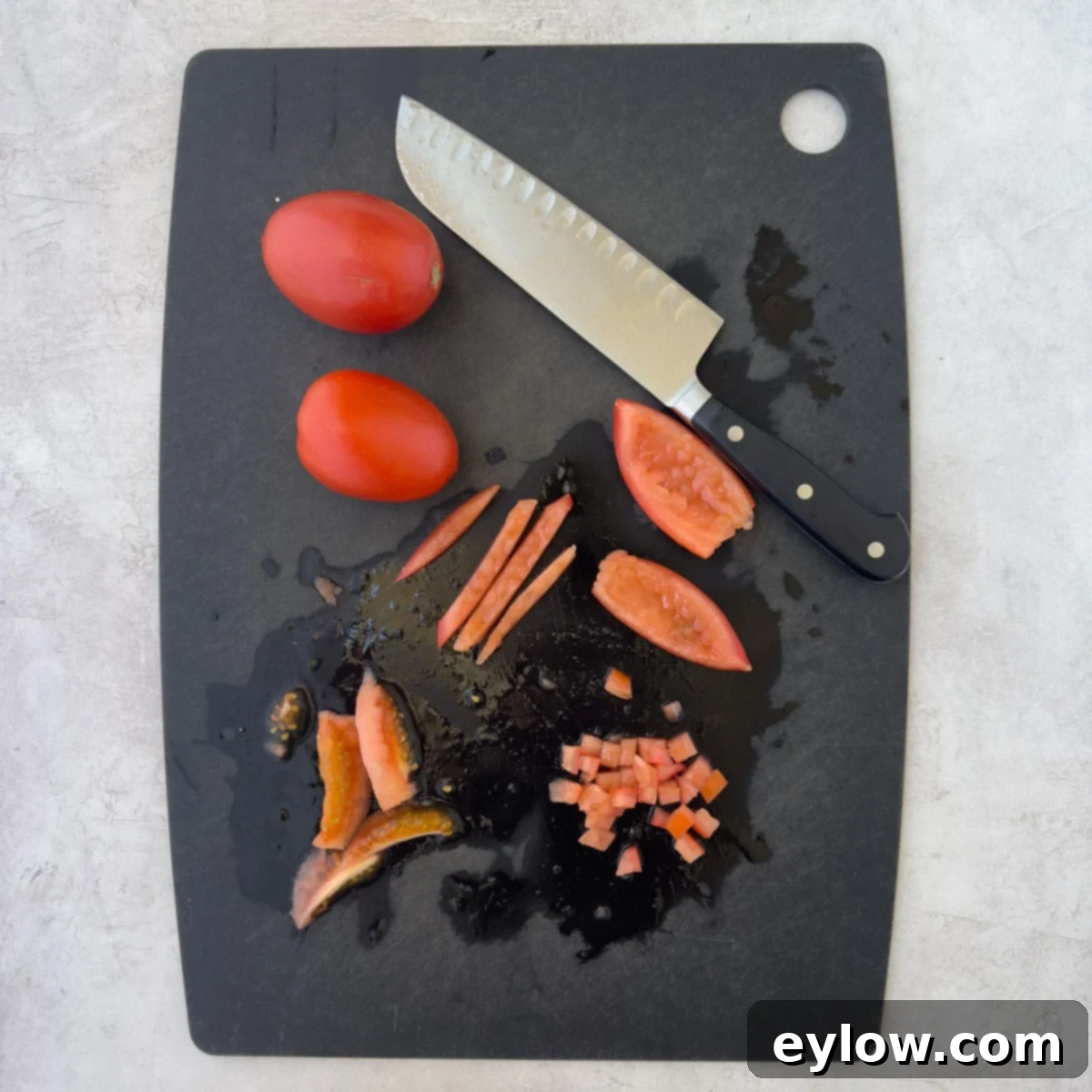
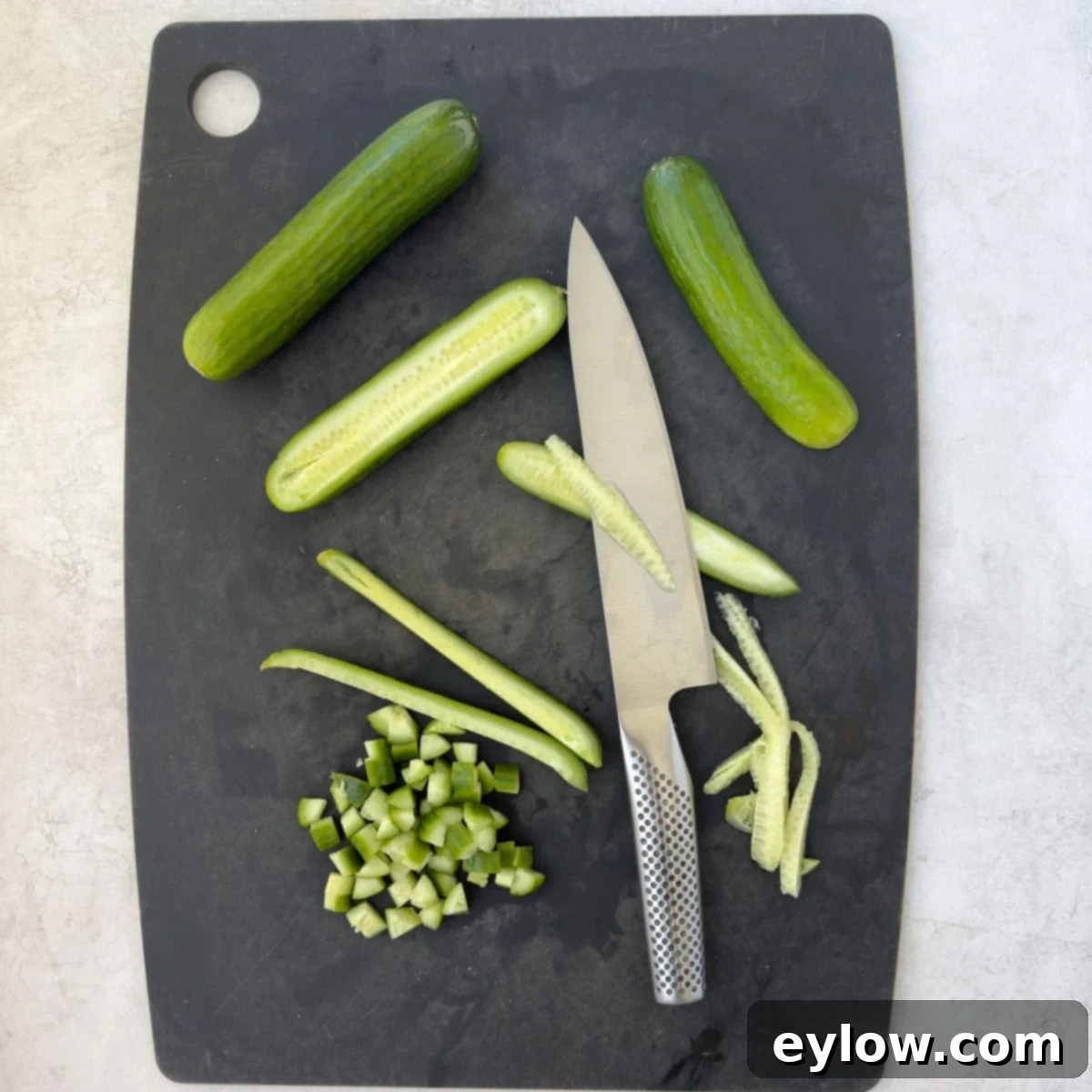

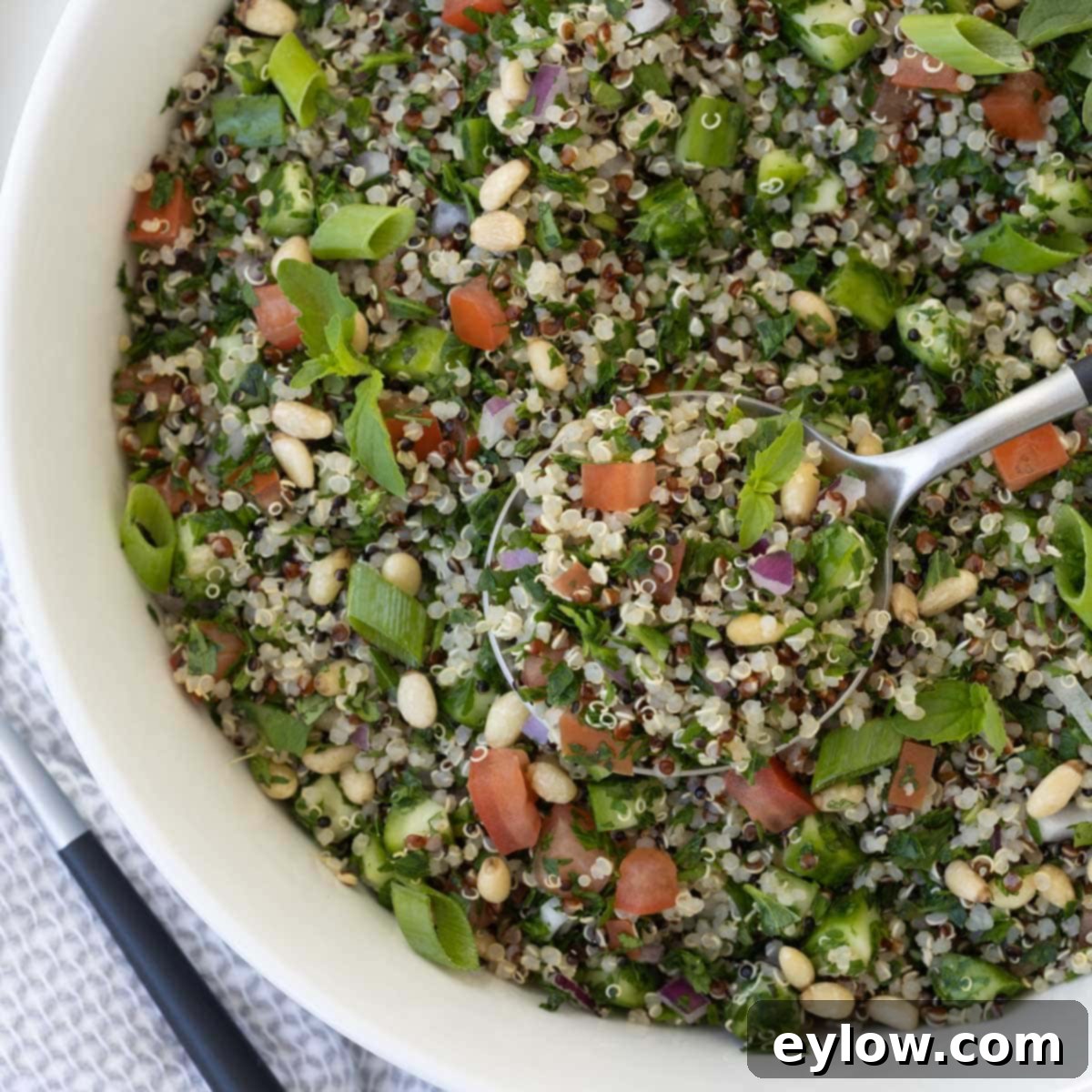
How to Dice Tomatoes Perfectly for Tabouli
Achieving perfectly diced tomatoes is key to a light and fluffy tabouli, preventing it from becoming watery or soggy. By removing the seedy, juicy centers, you ensure that the salad maintains its crisp texture and vibrant flavors. This technique is not only good practice for knife skills but also significantly improves the overall quality of your tabouli. The same method can be applied to cucumbers for a consistent dice.

- First, carefully slice a small piece off the top and bottom of the tomato to create flat, stable ends.
- Next, slice the tomato in half lengthwise, then halve each piece again to create quarters.
- Holding your knife parallel to the cutting board, carefully slice out the juicy, seedy centers from each quarter. Discard these watery parts.
- Cut each quarter into long, thin strips. The thickness of these strips will determine the size of your final dice.
- Finally, chop across the strips to create uniform, small dice.
You can use this exact same method for dicing cucumbers. Quarter them, scoop out the soft, seedy middle, slice into long strips, and then chop into a nice, small dice. This ensures all your vegetables are a similar size for a harmonious salad.
Delicious Serving Suggestions for Quinoa Tabouli
This versatile quinoa tabouli salad is delightful served either at room temperature or lightly chilled, making it incredibly flexible for various dining occasions. Its bright, fresh profile makes it a superb standalone dish, or you can pair it with a range of proteins for a more complete meal.
Consider serving it alongside grilled meats like tender chicken breasts, succulent lamb chops, or flavorful beef kebabs. It’s also an excellent complement to grilled fish or shellfish, such as these grilled scallops (which you can enjoy with or without the prosciutto). The zesty notes of the tabouli beautifully cut through richer flavors. For a harmonious pairing, try it with this grilled lemon mint chicken breast recipe, as the lemon and mint in both dishes create a perfectly balanced flavor profile.
Beyond main courses, tabouli is fantastic as part of a mezze platter with hummus, pita bread, and olives, or as a vibrant addition to a picnic spread or potluck. It’s also excellent for meal prep; simply store any leftover tabouli in an airtight container in the refrigerator, where it will keep beautifully for 3-4 days. Remember to add any extra dressing just before serving leftovers to maintain freshness.
Common Questions About Quinoa Tabouli
To achieve the most delicious tabouli, focus on these key steps: first, thoroughly wash and then completely dry your fresh herbs. This ensures they chop finely without clumping. You can chop them by hand with a sharp chef’s knife or, for a very fine texture, drop them into a running food processor. Next, ensure your tomatoes and onions are diced small and consistently. For the grain, choose either fine bulgur for a traditional tabouli or quinoa for a fantastic gluten-free alternative that’s light and fluffy. Finally, prepare a simple, fresh lemon and olive oil vinaigrette, and toss the salad with it just before or at serving time to keep everything vibrant and fresh.
Tabouli is traditionally served as a refreshing side dish or part of a larger mezze spread. However, it can easily be transformed into a satisfying complete meal. To make it more substantial, consider adding cooked garbanzo beans (chickpeas) for a robust vegan option, or top it with slices of grilled chicken, flaked fish, or grilled shrimp. Incorporating ingredients like crumbled feta cheese and toasted pine nuts will also significantly boost its protein content, making it a hearty and balanced meal on its own.
Absolutely, quinoa is a truly excellent and highly recommended substitution for bulgur in tabouli. Not only does it make the dish entirely gluten-free, but quinoa also offers a wonderful light and fluffy texture, a mild nutty flavor, and a complete protein profile. Its delicate grains absorb the dressing beautifully and blend seamlessly with the other fresh ingredients, providing a nutritious and delicious twist on the classic recipe.
When stored undressed in separate airtight containers, the cooked quinoa and chopped vegetables can last 2-3 days in the refrigerator. Once assembled and dressed, the tabouli is best enjoyed within 1-2 days. The herbs may start to wilt and the flavors can become less vibrant after that, though it will still be safe to eat for up to 3 days.
While fresh mint provides the absolute best flavor and aroma for tabouli, dried mint can be used in a pinch. If substituting, use about one-third the amount of dried mint compared to fresh, as its flavor is much more concentrated. However, for that truly refreshing and authentic taste, fresh mint is highly recommended and worth seeking out.
More Terrific Salad Recipes to Explore
If you’re craving more fresh and flavorful salad ideas, we’ve got you covered! From crisp leafy green salads to hearty vegetable-based creations like this Mediterranean potato salad, there’s a world of inspiration waiting. Dive into our dedicated salad recipes category page for even more delicious and healthy options that are perfect for any season or meal.
- Tossed Greek Green Salad
- Strawberry Goat Cheese Salad
- Lentil Quinoa Salad with Lemon Vinaigrette
⭐️Did you Make This Recipe?
If you’ve had the pleasure of making this delicious Quinoa Tabouli Salad, we’d love to hear about your experience! Please take a moment to add your comment below. Your feedback is invaluable, and we truly enjoy hearing from you. If you absolutely loved this recipe, consider giving it a 5-star rating! Your ratings and reviews are incredibly helpful to other readers who are looking for their next favorite dish.
📖 Recipe
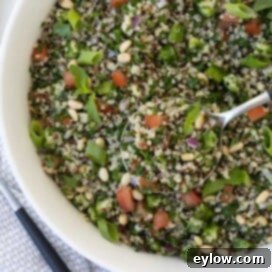
Quinoa Tabouli Salad (Tabbouleh)
Sally Cameron
Pin Recipe
Equipment
-
salad spinner
-
Chef’s knife
Ingredients
Quinoa Tabouleh Salad
- ¾ cup quinoa white or tri-color blend, rinsed thoroughly
- 2 Persian cucumbers diced small (substitute with half a large English seedless cucumber, seeded and diced)
- 2 Roma tomatoes seeded and chopped small
- 2 large bunches fresh parsley curly or flat leaf, finely chopped (stems removed)
- 1 small bunch fresh mint leaves finely chopped
- ¼ red onion chopped fine
- 3 green onions or scallions chopped fine
Lemon Vinaigrette
- 6 tablespoons extra virgin olive oil
- 3 tablespoons fresh lemon juice
- 1 large garlic clove very finely chopped or zested with a microplane
- ¼ teaspoon sea salt
- ⅛ teaspoon ground black pepper
Instructions
Rinse and Cook Quinoa
-
Begin by washing your raw quinoa thoroughly. Place it in a fine-mesh sieve and rinse well under cold running water, using a sprayer attachment if you have one. Alternatively, soak and stir it in a bowl of cold water, then drain and repeat the washing process. This step is crucial for removing saponins, which can give quinoa a bitter taste.
-
Cook the rinsed quinoa according to package directions, typically using a 2-quart pan with 1 ½ cups of water for ¾ cup quinoa. Bring the water to a boil, then add the quinoa. Reduce the heat to a low simmer, cover with a lid, and cook until all the water is absorbed, which usually takes about 15 minutes. Once cooked, turn off the heat and let it stand covered for an additional 10 minutes to finish steaming. The grains should be light and fluffy, with the germ ring unfurled. For quick cooling and to maintain its fluffy texture, spread the cooked quinoa thinly on a rimmed baking sheet and let it cool completely before adding to the salad.
Prepare the Vinaigrette and Vegetables
-
While the quinoa is cooking and cooling, prepare your vinaigrette and chop the vegetables and herbs. To make the vinaigrette, combine all the dressing ingredients (olive oil, fresh lemon juice, finely chopped garlic, sea salt, and black pepper) in a small bowl and whisk them together vigorously until well combined. This recipe yields a bit extra dressing, so you’ll have some on hand if needed. For the cucumbers and tomatoes, quarter them, then carefully slice out the seedy center. Cut each quarter into long strips, and then cut across these strips into a fine, uniform dice. This method helps prevent the salad from becoming watery.
Refer to the photos and the “How to Dice Tomatoes Perfectly” section in the post above for detailed visual guidance.
Mix and Dress the Salad
-
Once the quinoa is completely cool, transfer it to a large mixing bowl. Add the diced cucumbers, tomatoes, finely chopped red and green onions, and the finely chopped parsley and mint. Gently mix all the ingredients together until everything is evenly distributed. When you’re ready to serve, add a few tablespoons of the prepared lemon vinaigrette and toss gently. The goal is to lightly flavor the salad without soaking it. Serve the tabouli chilled, with any remaining dressing offered on the side for those who prefer more.
Notes
Variations:
- For a creamy, salty tang, crumbled or cubed feta cheese (or fresh goat cheese) makes a wonderful addition.
- Want to add more color and visual appeal? Experiment with using a mix of red and yellow heirloom tomatoes.
- If you prefer a tabouli with a lighter, more uniform color, choose only white quinoa.
- For added texture, fiber, and protein, rinse and drain a can of chickpeas (garbanzo beans) and stir them into the salad.
- Elevate the flavor and crunch with toasted pine nuts, a common and delicious addition in Mediterranean cuisine.
- Add finely diced bell peppers (red, yellow, or orange) for extra sweetness and crunch.
- A tiny pinch of ground allspice or a touch of sumac can add an interesting depth of flavor, though not traditional in all tabouli recipes.
